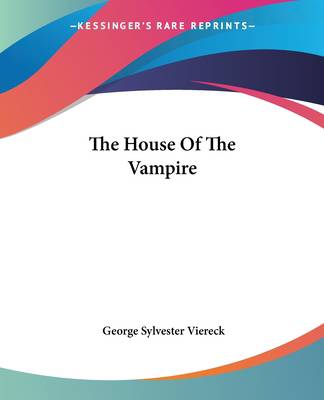
- Afhalen na 1 uur in een winkel met voorraad
- Gratis thuislevering in België vanaf € 30
- Ruim aanbod met 7 miljoen producten
- Afhalen na 1 uur in een winkel met voorraad
- Gratis thuislevering in België vanaf € 30
- Ruim aanbod met 7 miljoen producten
Zoeken
Omschrijving
The House of the Vampire is a gothic horror novel written by George Sylvester Viereck. The story follows a young man named Rudolph, who moves into a mysterious mansion in the countryside of New England. The mansion is owned by an enigmatic and charismatic man named Count Johann von Kempelen, who becomes Rudolph's mentor and friend. However, as Rudolph spends more time in the mansion, he begins to uncover strange and unsettling secrets about the count and his past. As the story progresses, Rudolph becomes increasingly obsessed with the count and his vampiric nature. He also becomes entangled in a love triangle with the count and a young woman named Giselle. The novel explores themes of obsession, love, and the supernatural, and is considered a classic of early 20th-century horror literature. The House of the Vampire was first published in 1907 and has since been adapted into several films and television shows. It is a must-read for fans of gothic horror and vampire fiction.The boy's expression was pleasant, with an inkling of wistfulness, while the soft glimmer of his lucid eyes betrayed the poet and the dreamer. The smile of Reginald Clarke was the smile of a conqueror. A suspicion of silver in his crown of dark hair only added dignity to his bearing, while the infinitely ramified lines above the heavy-set mouth spoke at once of subtlety and of strength. Without stretch of the imagination one might have likened him to a Roman cardinal of the days of the Borgias, who had miraculously stepped forth from the time-stained canvas and slipped into twentieth century evening-clothes.This scarce antiquarian book is a facsimile reprint of the old original and may contain some imperfections such as library marks and notations. Because we believe this work is culturally important, we have made it available as part of our commitment for protecting, preserving, and promoting the world's literature in affordable, high quality, modern editions, that are true to their original work.
Specificaties
Betrokkenen
- Auteur(s):
- Uitgeverij:
Inhoud
- Aantal bladzijden:
- 88
- Taal:
- Engels
Eigenschappen
- Productcode (EAN):
- 9781419166785
- Verschijningsdatum:
- 17/06/2004
- Uitvoering:
- Paperback
- Formaat:
- Trade paperback (VS)
- Afmetingen:
- 192 mm x 232 mm
- Gewicht:
- 167 g

Alleen bij Standaard Boekhandel
+ 33 punten op je klantenkaart van Standaard Boekhandel
Beoordelingen
We publiceren alleen reviews die voldoen aan de voorwaarden voor reviews. Bekijk onze voorwaarden voor reviews.








